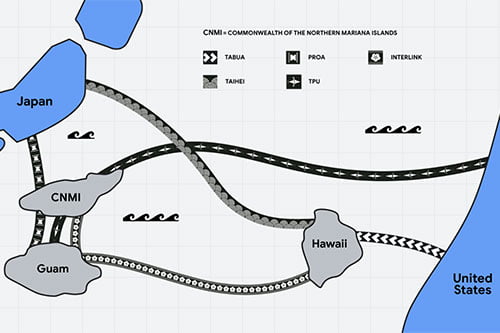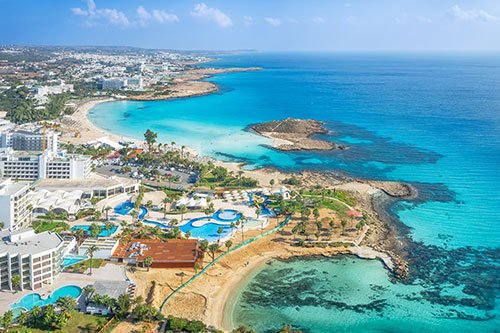Medusa Cable To Bring 480 More Tbps to Sines
The installation of Medusa is budgeted at 326 million euros and has funding from the European Investment Bank
 January 11, 2022
January 11, 2022
By Hugo Seneca,
Medusa is the name of the submarine cable that is in the process of securing authorizations from the Portuguese State to moor at the Start Campus in Sines, and at Carcavelos beach, in Cascais. The new AFR-IX Telecom cable will guarantee the connection of 8700 kilometers between Carcavelos and Port Said, in Egypt, and in between should ensure branches to different locations in Southern Europe and North Africa. In total that's 480 Terabits per second (Tbps) coming your way.
“There is a combination of factors that lead us to invest in this cable: in addition to the fact that there are some submarine cables in the Mediterranean that are reaching the end of their life cycle (and that need alternatives), it is known that the telecommunications traffic generated in Africa has grown at an average of 55% per year”, explained Norman Albi, executive director of AFR-IX Telecom, to Expresso , before the conference “Meetings at ZILS: Sines Tech, EU-Atlantic Data Gateway Platform “, which is taking place this Tuesday in Sines.
The installation of Medusa is budgeted at 326 million euros and is financed by the European Investment Bank. Norman Albi informs that the new submarine cable “has the state of the art of fiber optic technologies”, but recalls that the most differentiating feature “is in the fact that we are using an ‘open' cable, which can be connected to any type of technology or brand”.
AFR-IX's main customers are telecommunications operators, companies specialized in data processing and content producers. More recently, projects for the installation of submarine cables have emerged, led by content producers (Google and Facebook are the best known) or by consortia of telecommunications operators.
Albi is convinced that there is room for everyone: “We are neutral and provide services to anyone who asks us. And we can also present alternative services with routes that may not be very interesting for cables managed by content producers or by consortia of telecommunications operators”, he emphasizes.
In addition to Carcavelos and Sines, the route designed for Medusa includes moorings in several locations in Spain, France, Italy, Egypt, Algeria and Morocco. Among the main connection points, there is one that deserves greater attention: the connection to Marseille, a French city that is home to the main conglomeration of mooring points and infrastructure linked to Europe's submarine cables.
Among the national authorities, there is an expectation that the connection to the Mediterranean can reinforce the strategic value of the cable mooring unit and the data centers that are being designed for Sines – and that the connection to South America recently was guaranteed by the opened Ella Link the first starting shot.
The arrival of another submarine cable may serve as a reference for the remaining operators to have Sines on the radar of future investments, which intends to take advantage of the existence of facilitated interconnections to other stops. The national strategy intends to attract more submarine cables, but in Sines there is an expectation to add to the submarine cable mooring the potential of a data processing and storage center that should start operating at the end of 2022.
“Portugal does not want to be just the beach where submarine cables that come from other countries are tied up”, explains Filipe Costa, executive director of AICEP Global Parques. AICEP Global has been participating in the installation of the new large data center next to the Port of Sines, in a space known as Start Campus. This data center will be installed with investments of 3.5 billion euros from funds Davidson Kempner, from the US, and Pioneer Point Partners, from the UK.
On December 29, the deed was signed for the first nine hectares that will house the first module of this data center which, in addition to being on par with the largest in Europe, should be supported by renewable energy and, eventually, cooled by seawater.
This first module, whose energy consumption will require the installation of a capacity of 15 megawatts (MW), should be built to ensure operation by the end of 2022 – but the project covers a total of 60 hectares, and the installation of a capacity of 495 MW, which should only be achieved with the construction of four more modules over the next few years.
Filipe Costa recalls that, to date, submarine cables docked at different points in Europe, but traffic was, in most cases, routed for processing in London, Frankfurt, Paris or Amsterdam. In addition to guaranteeing mooring points that other European cities cannot provide, Sines intends to make a difference with a unit that separates traffic according to customers or operators, and provides data storage units on site.
“Sines and Lisbon function as gateways to the Atlantic and to West Africa”, underlines Norman Albi, regarding the favorable strategic positioning of the Portuguese coast.
In addition to geography, the chain of advantages is added: when the EU, Brazil and other Latin American countries decided to support the installation of the Ella Link submarine cable, with a bandwidth of 100 Tbps, they aimed to establish a direct connection between Sines and Fortaleza, Brazil, without passing through the USA.
In addition to issues of digital sovereignty, this direct link has a much smaller length than would be required to link Latin America, North America and Europe – and this factor promises to reduce the latency (the waiting time for communications to take effect) required. in the connections between Latin America and Europe.
Once the Ella Link was confirmed, the conditions were created for the new large data center that will be installed at the Start Campus in Sines. And possibly, the announcement of the future data center ended up helping the arrival of Cape Medusa – and others that have already been announced or are in the process of being announced.
“The installation of one cable attracts other cables; and the installation of a data center like the one we are developing in Sines should attract even more cables”, adds Filipe Costa.
According to the Directorate General for Natural Resources, Security and Maritime Services (DGRM), there are four ongoing processes for the mooring of four submarine cables in Portugal by 2025. Two of them are led by Facebook and Google (the rest were not revealed due to to the fact that promoters have not yet officially announced them).
Medusa could be named as the third known project in recent times – and it is possible that other similar projects will be announced in the near future. At DGRM, there is an expectation that the guaranteed bandwidth by sea will increase, by six to eight times, with the new submarine cables that have already started to be designed.
The morphology of the coast, which allows for a deep and rocky sea, and the lack of drainage can make Sines a place of choice to attract more cables and even more data centers that intend to join the project led by the Davidson Kempner and Pioneer Point partners funds. . Urban pressure and limits to construction can also make an important contribution to capturing more data centers for Sines.
“When we talk about large data centers that consume renewable energy, we don't think about urban areas (as happened in the past in Paris, London or Frankfurt)”, explains Filipe Costa.The leader of AICEP Global Parques is convinced that the technological duo carried out by submarine cables and data centers can reverse the historical peripheral characteristic in Portugal's favor, and can also help catapult the country towards the so-called “data economy” and accelerate the digital transition, while ensuring faster communications and external investment.
In mainland Portugal, the mooring of submarine cables has privileged Carcavelos, Seixal and Sesimbra – and the three points are on the outskirts of Lisbon. For redundancy reasons, it is likely that these locations will continue to be used for future moorings.
Filipe Costa believes that the moorings for Sines do not necessarily have to divert the connections planned for the outskirts of Lisbon. “Our objective is not to bring to Sines the cables that are tied around Lisbon. Our objective is to bring to Sines the cables that intend to process data, preventing them from ending up in other countries”, he concludes.
 January 11, 2022
January 11, 2022










